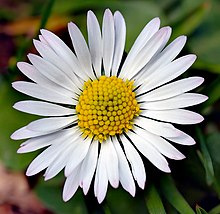Bellis perennis
| Bellis perennis | |
|---|---|
 |
|
| Scientific classification | |
| Kingdom: | Plantae |
| (unranked): | Angiosperms |
| (unranked): | Eudicots |
| (unranked): | Asterids |
| Order: | Asterales |
| Family: | Asteraceae |
| Genus: | Bellis |
| Species: | B. perennis |
| Binomial name | |
|
Bellis perennis L. |
|
| Synonyms | |
|
|
Bellis perennis is a common European species of daisy, of the Asteraceae family, often considered the archetypal species of that name.
Many related plants also share the name "daisy", so to distinguish this species from other daisies it is sometimes qualified as common daisy, lawn daisy or English daisy. Historically, it has also been commonly known as bruisewort and occasionally woundwort (although the common name woundwort is now more closely associated with Stachys (woundworts)). Bellis perennis is native to western, central and northern Europe, but widely naturalised in most temperate regions including the Americas and Australasia.
It is an herbaceous perennial plant with short creeping rhizomes and rosettes of small rounded or spoon-shaped leaves that are from 3/4 to 2 inches (approx. 2–5 cm) long and grow flat to the ground. The species habitually colonises lawns, and is difficult to eradicate by mowing - hence the term 'lawn daisy'. Wherever it appears it is often considered an invasive weed.
The flowerheads are composite, in the form of a pseudanthium, consisting of many sessile flowers about 3/4 to 1-1/4 in (approx. 2–3 cm) in diameter, with white ray florets (often tipped red) and yellow disc florets. Each inflorescence is borne on single leafless stems 3/4 - 4 in (approx. 2–10 cm), rarely 6 in (approx. 15 cm) tall. The capitulum, or disc of florets, is surrounded by two rows of green bracts known as "phyllaries".
B. perennis generally blooms from early to midsummer, although when grown under ideal conditions, they have a very long flowering season and will even produce a few flowers in the middle of mild winters.
It can generally be grown in USDA Zones 4 - 8 (i.e. where minimum temperatures are above −30 °F (−34 °C)) in full sun to partial shade conditions, and requires low or no maintenance. It has no known serious insect or disease problems and can generally be grown in most well-drained soils. The plant may be propagated either by seed after the last frost, or by division after flowering.
...
Wikipedia
